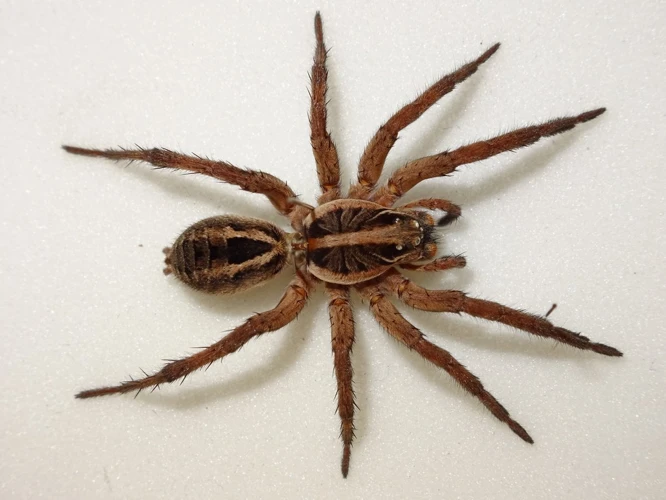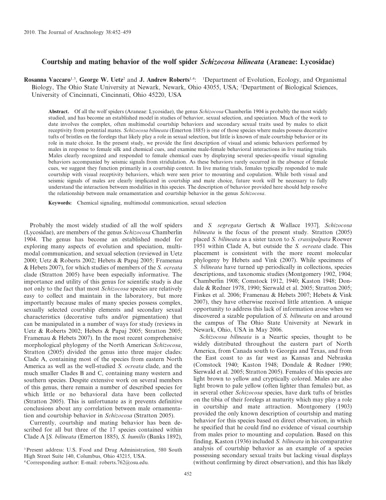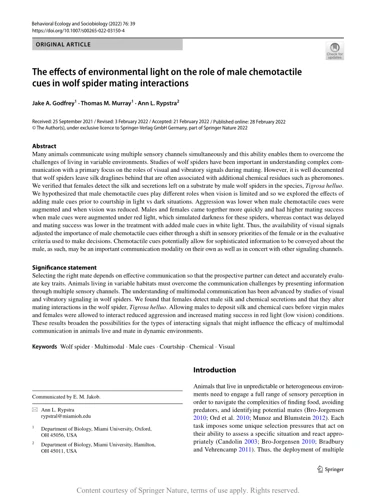Introduction

The world of arachnids is diverse and fascinating, with thousands of species inhabiting various environments across the globe. One such species is the wolf spider, known for its unique hunting abilities and interesting mating behavior. While much is known about the hunting habits of these spiders, their mating behavior is still a topic of ongoing research and study. In this article, we delve into the influence of environmental factors on wolf spider mating behavior, uncovering the role of temperature, lighting, humidity, and seasonal changes. We also examine the courtship rituals and mating strategies employed by these spiders, shedding light on the complexities of their reproductive practices.
Overview of Wolf Spiders
Wolf spiders are a unique species of arachnids that belong to the family Lycosidae. They are found in almost all parts of the world, with more than 2,300 species identified so far. These spiders are known for their fast movements and hunting abilities, aided by their keen eyesight. Wolf spiders are also unique in that they do not spin webs to catch prey. Instead, they actively hunt for insects and other small prey, pouncing on them quickly.
There is little sexual dimorphism among wolf spiders, with males and females looking similar, although females are often larger than males. Wolf spiders are solitary creatures, with the exception of mating season. During this time, males actively seek out female wolf spiders to mate with. To understand the intricacies of wolf spider mating behaviors better, we need to explore the environmental factors that influence their mating habits.
Factors Influencing Mating Behavior

When it comes to studying the mating behavior of wolf spiders, there are various factors that come into play. The complex interplay of environment and physiological factors significantly influences the mating habits of these arachnids. From temperature to humidity, and lighting to seasonal changes, every element has its impact. Understanding these factors can help researchers gain valuable insights into wolf spider mating behavior. Let’s take a closer look at some of the most critical elements that affect how wolf spiders mate.
Temperature
Temperature plays a crucial role in the mating behavior of wolf spiders. Wolf spiders are ectothermic, meaning that their body temperature changes with the external temperature. This implies that their activity levels and mating behavior are also affected by ambient temperature. A study conducted by Nyffeler et al. in 1994 showed that there is a direct correlation between the temperature and the frequency of courtship behaviors of wolf spiders.
In general, wolf spider mating behavior tends to be more active at higher temperatures. High temperatures lead to a higher metabolic rate, which can increase the energy available for mating behavior. Warmer temperatures can accelerate the development of wolf spiders into adults, which in turn increases their chances of mating. However, excessively high temperatures can also have negative effects, causing dehydration and even death.
On the other hand, low temperatures can reduce or stop the mating behavior of wolf spiders. When temperatures are too low, the spiders become sluggish and their movements become slower, which can make it difficult for males to locate females. In some cases, low temperatures can even induce hibernation-like states in wolf spiders, which can last for several months until the temperature increases.
Temperature is an influential environmental factor that affects the mating behavior of wolf spiders. The optimal temperature range for wolf spider mating behavior is typically between 20 to 30 degrees Celsius. Within this range, wolf spiders become more energetic and active, and their mating behavior is more frequent. However, excessively high or low temperatures can have negative effects on the mating behavior of wolf spiders. Understanding the relationship between temperature and wolf spider mating behavior can help us to better conserve and manage wolf spider populations in the wild. If you want to learn more about the courtship rituals of wolf spiders, follow this link.
Lighting
Lighting is another crucial factor that influences the mating behavior of wolf spiders. Wolf spiders have poor eyesight and use their sense of touch more than their eyes to navigate their environment. However, they are known to be sensitive to changes in lighting conditions. Studies have shown that lighting can affect the pattern and frequency of courtship behaviors in wolf spiders.
Darkness: Wolf spiders are nocturnal creatures and are more active in the dark. In the absence of light, male wolf spiders tend to be more exploratory and are more likely to encounter a potential mate. A darker environment can also lead to more frequent courtship behaviors as male wolf spiders rely more heavily on tactile cues to locate a female.
Bright Light: Exposure to bright light can affect the behavior of wolf spiders. Male wolf spiders may be less active and more hesitant to approach a potential mate in well-lit areas. Female wolf spiders, on the other hand, may be more active and exhibit more aggressive behaviors in brighter lighting conditions. This may be because they are more vulnerable to predators in well-lit areas and need to be more alert.
UV Light: Some studies have shown that wolf spiders are sensitive to UV light and may use it as a means of communication. For example, male wolf spiders have been observed using UV mark on the females to indicate that they have already mated. UV light can also help female wolf spiders locate potential mates, as they may use the UV patterns on male wolf spiders’ bodies to identify them.
Lighting plays a crucial role in the mating behavior of wolf spiders. It can affect the frequency and pattern of courtship behaviors and even serve as a means of communication between individuals. Understanding the influence of lighting on wolf spider mating behavior can provide valuable insights into the evolution of their mating systems.
If you are interested in learning more about wolf spider mating behaviors, check out our article on Wolf Spider Mating Behaviors.
Humidity
Humidity plays an essential role in the mating behavior of wolf spiders. Wolf spiders are found in a variety of habitats worldwide, and their mating behavior is influenced by the humidity levels in their environment. Research has shown that humidity can significantly affect the courtship and mating success of wolf spiders.
Humidity Levels and Mating Success
For wolf spiders, the optimal humidity level for mating varies by species. However, studies have shown that humidity levels from 60% to 80% are generally ideal for wolf spider mating behavior. High humidity also increases the chances of successful egg production following mating. On the other hand, a lack of humidity can lead to a reduction in the frequency and length of mating behavior, which can ultimately lower mating success rates.
In a study conducted on the wolf spider species, Pardosa milvina, researchers found that high humidity significantly increases the duration of the mating process. The research showed that when the humidity level was between 60% and 80%, the duration of the mating process was significantly higher than when the humidity level was lower. The increased humidity level resulted in a more prolonged and more successful courtship and mating process in Pardosa milvina.
Similar studies conducted on other wolf spider species have also supported the idea that humidity plays a crucial role in the mating success of wolf spiders. For instance, in Schizocosa spp., high humidity led to a significant increase in the frequency of courtship behaviors while a lack of moisture resulted in a reduction in courtship behavior.
To sum up, humidity significantly influences the mating success and behavior of wolf spiders. Maintaining a suitable humidity level is crucial for wolf spiders to have successful courtship and mating behaviors which eventually lead to egg production.
Understanding the reproductive cycle of female wolf spiders is equally important to comprehend how humidity can impact mating success and egg production in wolf spiders.
| Humidity Levels | Mating Behavior and Successes |
|---|---|
| 60% to 80% | optimal for mating and egg production |
| Below 60% | reduction in mating behavior and success |
Seasonal Changes
Seasonal changes play a crucial role in the mating behavior of wolf spiders. As with most animals, wolf spider mating habits are affected by changes in seasons, particularly in temperature and daylight hours.
During the colder months, wolf spiders become less active and spend more time in hibernation. As the temperatures begin to rise in the spring and summer months, they become more active and start to mate. Male wolf spiders start to search for females, and their behavior is highly affected by the availability of prey and heating patterns.
Female Wolf Spiders (Link to /wolfspider-pheromones-mating/)
Female wolf spiders are more active during the fall and spring when they start to produce pheromones to attract males. They usually mate once in their lifetime, and this occurs just before they lay their eggs. There is usually a giant disparity between the size of male and female wolf spiders, and they have unique mating strategies to ensure reproductive success.
Male Wolf Spiders
During mating season, male wolf spiders will actively pursue females. They use their sense of smell to locate potential mates, with pheromones playing a vital role in the attraction. Once a male locates a female, he will perform a series of courtship displays to win her over.
Mating-related Cannibalism (Link to /mating-cannibalism-wolf-spiders/)
One of the most unique aspects of wolf spider mating behavior is the prevalence of cannibalism during courtship behaviors. Male wolf spiders have to be careful during mating, as females will often eat them even during copulation. Such behavior can go either way, though. Females could end up as victims of males. This means that the sexual cannibalism is not always advantageous as it is risky.
Seasonal changes have a significant impact on wolf spider mating habits. Females produce pheromones during fall and spring, and males respond to those pheromones during the mating season. Male wolf spiders perform courtship behaviors to attract females, while females will carry out cannibalism to ensure reproductive success. More active wolf spiders make more offspring, although the risk of cannibalism is always present.
Mating Habits of Wolf Spiders
It’s fascinating to delve into the world of wolf spiders and examine how they interact when it comes to mating. These spiders don’t have the typical mating habits one might assume for an arachnid species. They have unique courtship rituals that they use to attract their mates, and they’re also selective when it comes to choosing who they’ll mate with. Let’s take a closer look at the intriguing mating habits of these spiders and learn more about how they go about finding a partner. For more information on wolf spider mating, be sure to check out our article on mating systems of wolf spiders.
Courtship Rituals
When it comes to wolf spider mating behavior, their courtship rituals are a fascinating sight to see. Male wolf spiders typically initiate the courtship process by performing a series of physical movements to attract potential mates.
The following table illustrates the courtship process of wolf spiders:
| Step | Description |
|---|---|
| Approach | The male wolf spider approaches the female slowly and cautiously. |
| Vibrations | The male begins to vibrate his body rhythmically. This movement helps to create vibrations that the female can sense. |
| Visual display | The male performs a visual display, which may involve lifting his legs and spreading out his pedipalps. |
| Retreat | The male may retreat for a moment, then approach the female again, repeating the previous steps. |
| Mounting | If the female is receptive, the male will mount her and insert his pedipalps into her genital opening. |
| Copulation | The male and female wolf spiders will remain in copulation for several minutes to several hours. |
It is interesting to note that some female wolf spiders are known to be quite aggressive during the courtship process, and will attack males that they deem unworthy. Additionally, researchers have found that male wolf spiders are more successful in attracting mates when they are larger and have longer legs. You can read more about wolf spider size and mating in our related article “The Relationship Between Wolf Spider Size and Mating Success.”
The courtship rituals of wolf spiders can be complex and fascinating to observe. Researchers continue to study these behaviors to gain a better understanding of the factors influencing wolf spider mating behavior.
Mating Strategies
When it comes to mating strategies, wolf spiders have some unique and fascinating ways of ensuring successful reproduction. Here are some of their most notable methods:
- Aggressive Behavior: Male wolf spiders are known to be aggressive towards potential mates and will use physical force to ensure their mating success. This behavior can lead to fierce fights between males who are competing for the same female.
- Chemical Communication: Both male and female wolf spiders use chemical signals to communicate with potential mates. These signals are released through pheromones, which can help spiders identify the gender and reproductive status of their partners.
- Object Presentation: Male wolf spiders often present a gift to females in an effort to establish mating. This gift can come in the form of food or silk, and is intended to persuade the female to accept the male’s advances.
- Multiple Mating: Female wolf spiders are known to mate with multiple partners and will actively seek out males for this purpose. This behavior can lead to competition among males and can also increase genetic diversity within a given population.
All of these strategies have evolved in response to the environmental factors that influence wolf spider mating behavior. For instance, aggressive behavior and object presentation may be more common when resources like food and shelter are scarce, while chemical communication and multiple mating may be more common when populations are dense. To learn more about the ways in which wolf spiders choose their mates, check out this article on mating preferences in wolf spiders. You can also read about the ways in which wolf spider mating behavior is influenced by factors like temperature, lighting, and humidity in the sections above.
Conclusion
After examining the various environmental factors that influence wolf spider mating behavior and studying their mating habits, it is evident that these creatures have a complex and fascinating reproductive system. The importance of temperature, lighting, humidity, and seasonal changes cannot be understated in their quest for a mate.
As mentioned earlier, male wolf spiders must be careful in their approach to females due to the risk of being mistaken for prey and becoming a meal instead of a mate. This has led to the evolution of elaborate courtship rituals, such as leg tapping and vibration signaling, to mitigate the danger of incorrect identification. Additionally, males may use chemical cues to recognize receptive females and avoid aggression from non-receptive individuals.
Females also have their own strategies for selecting suitable mates. Though physical appearance does not seem to be a critical factor in their decision-making process, certain traits like size and age can indicate better genetic fitness for their offspring. Ultimately, females will choose the male that displays the most impressive courtship and signals of good health.
Overall, the mating behavior of wolf spiders is a fascinating area of study for scientists and nature enthusiasts alike. As we continue to observe and learn more about these incredible creatures, we can gain a greater appreciation for the complexity and diversity of life on our planet. To further explore the topic of wolf spider mating choice, check out our article on How Wolf Spiders Choose Mates.
Frequently Asked Questions
How do wolf spiders choose their mate?
Male wolf spiders initiate courtship by detecting pheromones released by females. During dance-like rituals, males exhibit various behaviors to convince females to mate.
What temperature range is ideal for wolf spider mating?
Ambient temperature plays an important role in wolf spider mating behavior. They prefer temperatures around 20-25°C for successful mating.
Can wolf spiders mate in complete darkness?
Yes, wolf spiders can mate in complete darkness. However, they rely on vibrations and touch to locate and communicate with their mate.
How does lighting affect wolf spider mating?
Lighting can have a significant impact on wolf spider mating behavior. Bright light can cause spiders to become less active, less motivated to mate, and more likely to hide.
Can wolf spiders mate in high humidity conditions?
High humidity conditions can increase the likelihood of successful wolf spider mating. These spiders thrive in humid conditions and require moisture for proper reproduction.
Do male or female wolf spiders initiate mating?
Male wolf spiders typically initiate mating by detecting the pheromones released by females. However, females have been known to reject potential mates they deem unsuitable.
What mating strategies do male wolf spiders use?
Male wolf spiders use various strategies to ensure successful mating. Some display complex courtship dances while others sneak up on potential mates or mimic pre-existing pheromones.
What is the purpose of wolf spider courtship rituals?
Wolf spider courtship rituals serve several purposes including male personalization, mate assessment, and stimulation of female pheromone production.
When is the peak breeding season for wolf spiders?
The peak breeding season for most wolf spider species is in the late summer or early fall when temperatures are ideal, and prey is abundant.
Can environmental factors lead to the decline of wolf spider populations?
Yes, environmental factors such as habitat loss, pollution, and climate change can lead to the decline of wolf spider populations. This decline can have a significant impact on local ecosystems and food webs.






